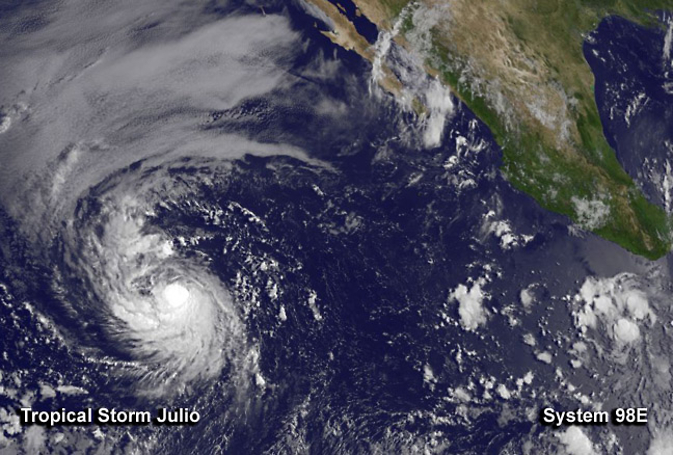NASA Sees Tropical Storm Julio as Part of a Heated Eastern Pacific

On August 5, NOAA's GOES-West satellite captured an image of the Eastern Pacific's Tropical Storm Julio and developing System 98E. Image Credit: NASA/NOAA GOES Project
“Ocean temperatures in the Eastern Tropical Pacific were heated up because of the strong Kelvin wave activity this spring. Although the initial excitement of an impending El Nino has quieted down, these warmer waters have caused an early and active hurricane season,” said Bill Patzert, Climatologist at NASA's Jet Propulsion Laboratory in Pasadena, California.
“Kelvin waves” are massive ripples in sea level that travel across the Pacific from Australia to South America. Forecasters are paying close attention because these waves could be a herald of El Niño.
“Today, two strong cyclonic systems, Iselle (a major category 4 hurricane) and weaker Julio have their sights set on the Hawaiian Islands,” Patzert said. “Hawaii is on high alert. Hurricane impacts in the Hawaiian Islands are quite unusual. Since 1950, only five hurricanes have made land-fall in the Islands. The good news is that both Iselle and Julio should weaken as they enter cooler ocean waters.”
On August 5, NOAA's GOES-West satellite captured an image of Tropical Storm Julio and developing System 98E located near southern Mexico's coast.
On August 5 at 11 a.m. EDT (1500 UTC) Tropical Storm Julio had maximum sustained winds near 60 mph (95 kph). The National Hurricane Center (NHC) expects Julio to become a hurricane tomorrow, Wednesday, August 6.
Julio was centered about 1,145 miles (1,845 km) west-southwest of the southern tip of Baja California, near latitude 14.0 north and longitude 124.7 west. Julio is moving toward the west near 13 mph (20 kph). NHC expects a general westward to west-northwestward motion to continue through Thursday.
To the east of Tropical Storm Julio is yet another developing area of low pressure. That area, designated as System 98E is located near 10.3 north latitude and 98.1 west longitude several hundred miles south of Acapulco, Mexico. It has a medium chance of developing into a tropical depression in the next two days.
For more information about Kelvin Waves and a developing El Nino, visit: http://science.nasa.gov/science-news/science-at-nasa/2014/19may_elnino/
Text credit: Rob Gutro
NASA's Goddard Space Flight Center
Media Contact
All latest news from the category: Earth Sciences
Earth Sciences (also referred to as Geosciences), which deals with basic issues surrounding our planet, plays a vital role in the area of energy and raw materials supply.
Earth Sciences comprises subjects such as geology, geography, geological informatics, paleontology, mineralogy, petrography, crystallography, geophysics, geodesy, glaciology, cartography, photogrammetry, meteorology and seismology, early-warning systems, earthquake research and polar research.
Newest articles

Biomarkers identified for successful treatment of bone marrow tumours
CAR T cell therapy has proven effective in treating various haematological cancers. However, not all patients respond equally well to treatment. In a recent clinical study, researchers from the University…

She deciphers how tomato roots communicate
Ora Hazak has always been fascinated by plants and is studying the signals that roots send to the rest of the organism. She aims to understand this communication in order…

Laser excitation of a nucleus
A long-awaited breakthrough opens the door to a new type of atomic clock and the investigation of fundamental questions in physics. After decades of investigation, researchers made an extraordinary quantum…





















